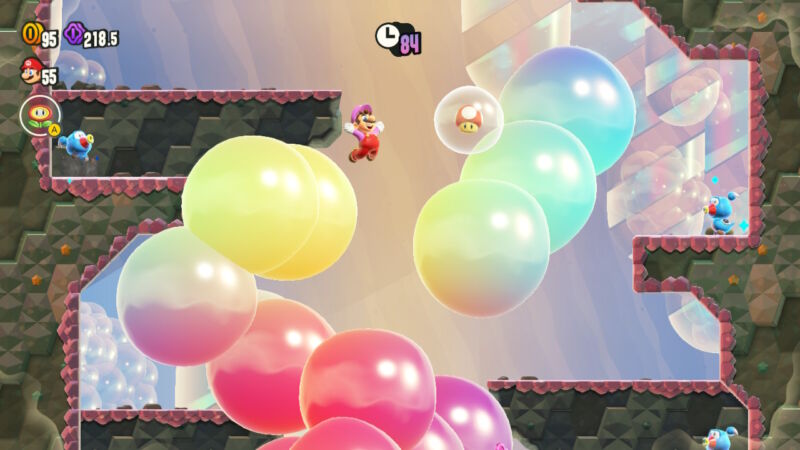Inspired “Wonder Flower” effects add to great sound and animation.
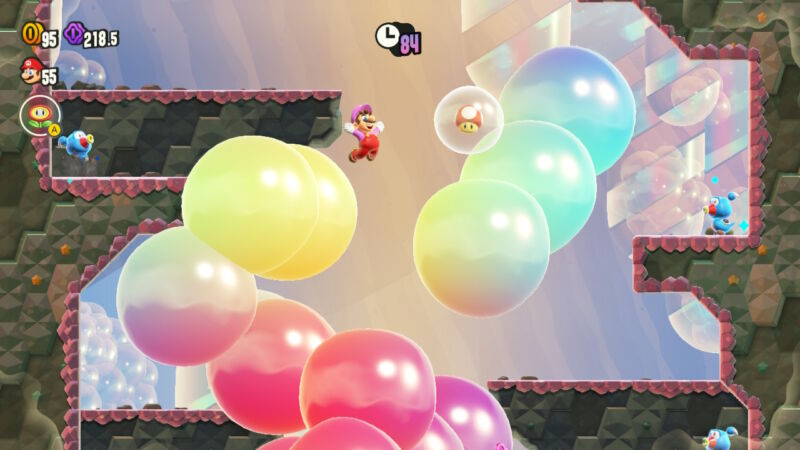
FURTHER READING
Masterpiece: Super Mario World 2: Yoshi’s Island
Back in 1995, Nintendo released Yoshi’s Island, which included the game’s seventh level, “Touch Fuzzy, Get Dizzy.” After a relatively sedate and predictable first half, the last part of “Touch Fuzzy, Get Dizzy” introduces the floating white puffballs that give the level its name (and its cult status among Mario fans). While touching most enemies in Yoshi’s Island causes damage or instant death, touching a fuzzy simply makes the entire level start to bob up and down like a series of ocean waves, as a wide-eyed Yoshi staggers back and forth like he’s 10 shots deep into an epic bender.
If you’ve played this level in Yoshi’s Island, you have some idea of what to expect in Super Mario Bros. Wonder.
Playing Super Mario Bros. Wonder, it feels like somebody at Nintendo asked, “What if we made a game where every level was like ‘Touch Fuzzy, Get Dizzy’?” Thankfully for us, someone at Nintendo apparently heard this question and said, “Sure, why not?”
Wonder-full flowers
The Wonder Flowers hidden in each level of Super Mario Bros. Wonder could have easily been a gimmick—the kind of repetitive, minor alterations to the status quo that help check a box on the game packaging. Instead, the Wonder Flower effects provide a much-needed shot in the arm that keeps the game from falling into anything approaching a predictable rut.
FURTHER READING
Hands-on with Mario Wonder, which freshens up one of Nintendo’s oldest formulas
Practically every Wonder Flower effect would feel more at home in some of the more inventive Super Mario World romhacks than in an official Nintendo-made title. Some effects make levels easier, like one that starts raining invincibility-granting Starmen that you can catch to run through the rest of the level with glee. Some make levels harder, like one that spawns a giant, crushing block to chase you down a block-filled tunnel, Mr. Driller style. And some change your perspective, like one that rolls up the entire level into a giant snowball with you running around on top.
With Wonder Flowers, you’ll see Mario tumble through the air like a skydiver, walk on the far wall in a level’s background, and ride on top of a herd of buffalo-like Bulrushes. You’ll ride on pipes that crawl like giant worms and sprint away from spiked boulders like you’re in a lost Indiana Jones sequel.Advertisement
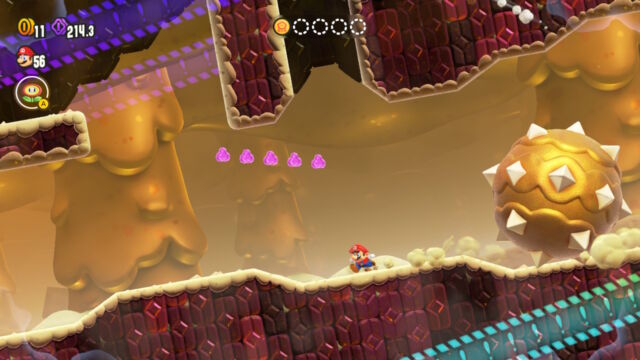
Nintendo has asked me not to go into detail on many of the Wonder Flower effects before the game is released. So, for now, I’ll just hint that Wonder Flowers can activate puzzle sections, completely alter Mario’s shape and size, and/or add some incredibly psychedelic audiovisual effects to the otherwise staid proceedings.
The level design in Super Mario Bros. Wonder has the series’ requisite cache of hidden blocks and exits, secret coin rooms, and other surprising hidden bits (as well as a surprisingly large collection of new enemies that look nothing like the hundreds of existing Mario enemies). But it’s the Wonder Flower effects that will make you eager to see just what the designers have in store for the next level.
I have the power!
In addition to the Wonder Flowers, Super Mario Bros. Wonder offers several new items and badges to spice up Mario’s ever-expanding list of abilities.
Of the three new standard power-ups, the mushroom that transforms Mario into an elephant is easily the most fun. You’ll be spamming the run button to swing your massive trunk, breaking through otherwise impassable blocks and knocking enemies clear across the screen. Sure, your elephant form may provide a bigger-than-ever target for enemies to damage you, and a simple fire flower might offer a better ranged attack, but it’s hard to compete with Elephant Mario for sheer gleeful impact.
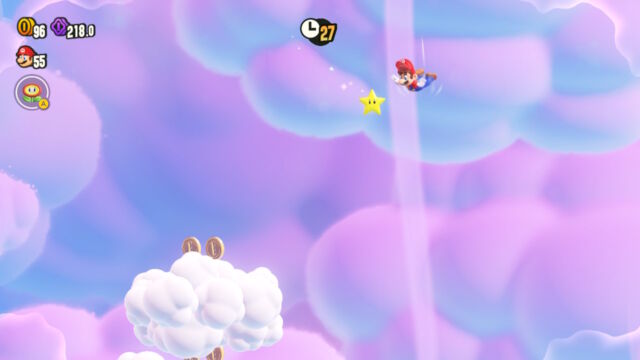
The new drill helmet, on the other hand, is the item most likely to make you look at levels with a new set of eyes. The ability to dig underground to slide beneath enemies and barriers, or into the ceiling to float above them, gives powerful new navigation options that often feel like Nintendo didn’t even consider them when making the levels.
But it’s the new bubble suit that somehow feels the most overpowered of the three new power-ups, letting you blow clear spheres that can destroy most fireproof enemies, even through walls. And while it’s tough to carefully position these bubbles to give you an extra bounce, it’s a skill worth mastering if you want to easily get to some otherwise hard-to-access corners and secrets.Advertisement
Beyond the standard power-ups, you can collect purple Wonder Coins to buy new badges from the many shops that dot Super Mario Bros. Wonder’s map. While you can’t lose a badge-granted power by getting hit by an enemy, you are limited to wearing a single badge for an entire level (though you can switch them up after you die).
The badges I appreciated most were those that helped expand Mario’s movement set. Early in the game, I leaned heavily on the Parachute Cap, which let me glide gently down from the peak of my jump. Later on in the game, I relied on another badge that also let me alter my jump trajectory in mid-air. (I can’t be more specific before the game’s release, but I will say that I want this particular badge to become a permanent part of Mario’s 2D move set ASAP.)
Other available badges let Mario jump higher, grab distant walls with a piranha plant grappling hook, or climb up walls with a useful vertical jump. Each one has its place, but for the most part, I was happy sticking with one of the powerful standard jump enhancers rather than changing things up every level.
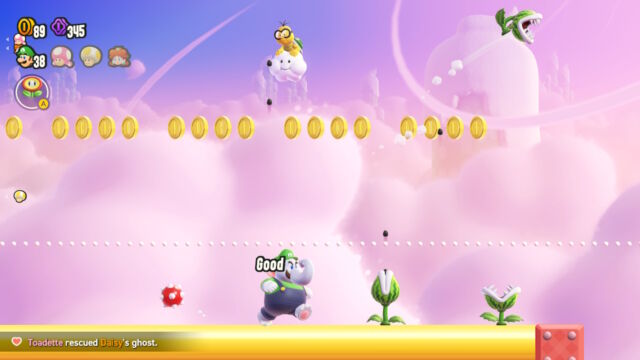
Beyond the core movement badges, though, I found most others relatively easy to ignore. Some were nearly useless, like a badge that gives extra coins for each defeated enemy (the extra lives granted by these coins are next to worthless in a game that you can save after every level). Some seem mainly useful only in very limited circumstances, like the Dolphin Kick badge that heavily increases your swimming speed and control.
Some seem designed as livestream gimmicks, like the Invisibility and Jet Run badges that make the game harder in most situations. And the worst badges are just incredibly boring, like one that gives Mario a Super Mushroom at the beginning of each level.
While I dig the concept of a semi-permanent power-up that lasts for an entire level, I hope future Mario games skip these less interesting badges and instead come up with additional new ways to give Mario even more pinpoint control over his speed and on-screen position.
A wonder to see and hear
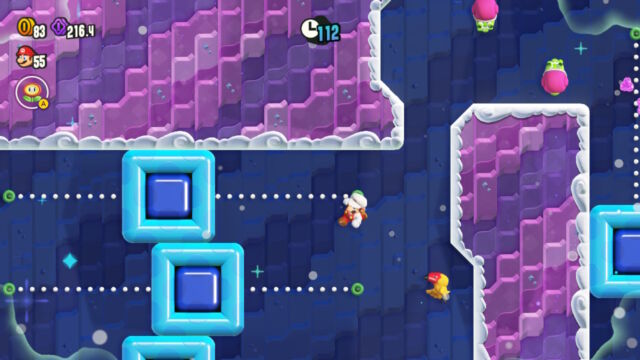
WHAT DID HE SAY?
Months after Nintendo announced the retirement of longtime Mario series voice actor Charles Martinet, Wonder marks the debut of new voice actor Kevin Afghani (whose previous roles include Arnold in Genshin Impact). After listening to Afghani’s whoops and woohoos for over a dozen hours, I can say that his take on the characters is slightly but not distractingly different, at least so far. We’ll see if that holds up in a game with more actual dialogue for the Mario brothers.
More than any other 2D Mario game, Wonder highlights how far we’ve come from the days of Mario’s flat sprites and four-frame run cycles on the NES. The game looks like a full-fledged animated cartoon, with characters that squash, stretch, and smear in ways that add a real sense of momentum and life to the proceedings.
This lively animation manifests in countless little touches you’ll notice as you play the game (especially if you play docked to a big-screen TV). It’s the way Mario’s feet become a literal blur when you reach top running speed or the joyful belly-forward thrust he makes at the peak of an especially high jump. It’s the way Mario’s hand darts out of a pipe to grab a cap he left behind in a rush or how a Goomba’s tiny face contorts in fear when a Maw-Maw threatens to eat it.
The Super Mario Bros. Wonder music and sound design teams also deserve a special shoutout here. The fact that the peppy background music will stick in your head all day is nothing new for a Mario game, of course. But the way the sound effects can gently integrate with that music—such as with rainbow-colored high-jump blocks that play a scale as you run across them—creates a fuller soundscape that morphs as you play.
Even the game’s ever-present talking flowers—which offer gentle jokes or encouragement as you run past—are less annoying than I expected. In fact, the only really annoying sound design choice I can point to is an intense, sweeping drumroll sound effect that threatens to drown out everything else every time you do a mid-air ground pound.
Bring some friends (or strangers)
While Mario games are historically focused on single-player gameplay, Nintendo has taken pains to redesign local and online multiplayer features in Wonder. Unlike recent New Super Mario Bros. games, for instance, players can no longer crash into or bounce off of each other when sharing the screen in co-op play (either locally or online with friends).Advertisement
This change makes it much easier to share the limited screen real estate without accidentally getting in each other’s way, though it does take away the option for some explicitly helpful cooperative moves (like carrying a partner over a gap). That said, a dead co-op player can come back as a ghost and return to the game without penalty by touching a living player. This makes it easy to escort younger and/or less experienced players through the toughest levels (and there are definitely some levels here that rank among the hardest in the 2D Mario games).
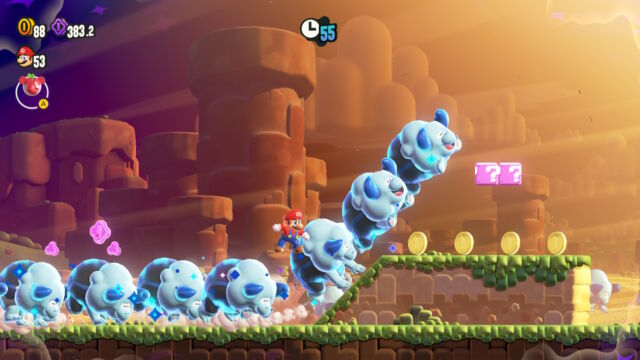
Super Mario Bros. Wonder
(Ars Technica may earn compensation for sales from links on this post through affiliate programs.)
Super Mario Bros. Wonder also introduces an even more passive form of online play for solo players, who have the option of seeing live and recorded ghosts of other players as they work through levels. While these can be useful for a post-death rescue, as in co-op, they’re even more interesting to use as hints pointing toward hidden secrets. A ghostly character that’s seemingly floating in mid-air, for instance, probably found a hidden block platform or Lakitu cloud that you might not know about yet.
Players can also leave flat “standees” that offer yet another way for player ghosts to come back after death. But even in the brief pre-release period, some players are also using standees to point out hidden blocks and other secrets. Those who want to avoid spoilers should turn off these passive online features, but those who appreciate Dark Souls-style, parasocial relationships with strangers will have fun feeling like just one Mario among many.
I could say a lot more about Super Mario Bros. Wonder, but some of my more specific thoughts will have to wait until after the game’s full release on October 20. For now, just know that the game is the most inventive and joyful 2D Mario title in decades, and it deserves a play by anyone who has fond memories of the little plumber.

